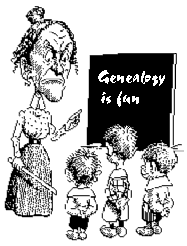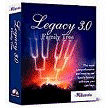First Step: Work backwards in researching your family. Start with yourself, your parents and your grandparents, as far back as you can go. Second Step: Talk to as many relatives and friends of relatives as you can! The "oldtimers" can be an excellent resource and will provide you with information that you would never find in any record! This is what makes family history interesting! Don't delay, because when they are gone, they are truly gone. Third Step: You must document your sources. This means that every little bit of information that you receive about your relatives and ancestors must be documented. Keep in the good habit of writing down exactly where and when you found the information, so that if you or even someone else can go look back and look up the record if need be. I even write down on each note, which repository it came from, as well as page numbers and the book or microfilm title. Every letter, pertinent email or article can also be used as a source, so be sure to reference them also. Fourth Step: Have a good filing system in place and make sure to cross-reference the different families the document pertains to. I usually keep the hundreds of photocopies I make in these files, split up into sections on each surname and then broken down into type of record (marriage, birth, census, etc)..This may seem like nitpicking, but it can be invaluable when you are searching for a particular document. All the irreplaceable and heirloom photos and documents are placed in a fireproof safe. If you want to display these, then make copies and use these for display purposes. Too much light will eventually destroy these photos. Ensure that the envelopes you store the originals in are acid free! Fifth Step: Include a good genealogy database program if you have a computer. I now use the FREE Legacy Family Tree. You can print beautiful books, charts and reports, plus it keeps track of everything that you collect in your research, keeping all your relatives and ancestors in order. Another good program is Family Tree Maker , although I don't think it is as versatile as Legacy. There are many other programs out there so please follow the link to compare them. |
Just Getting Started? |
First Step: Work backwards in researching your family. Start with yourself, your parents and your grandparents, as far back as you can go. Second Step: Talk to as many relatives and friends of relatives as you can! The "oldtimers" can be an excellent resource and will provide you with information that you would never find in any record! This is what makes family history interesting! Don't delay, because when they are gone, they are truly gone. Third Step: You must document your sources. This means that every little bit of information that you receive about your relatives and ancestors must be documented. Keep in the good habit of writing down exactly where and when you found the information, so that if you or even someone else can go look back and look up the record if need be. I even write down on each note, which repository it came from, as well as page numbers and the book or microfilm title. Every letter, pertinent email or article can also be used as a source, so be sure to reference them also. Fourth Step: Have a good filing system in place and make sure to cross-reference the different families the document pertains to. I usually keep the hundreds of photocopies I make in these files, split up into sections on each surname and then broken down into type of record (marriage, birth, census, etc)..This may seem like nitpicking, but it can be invaluable when you are searching for a particular document. All the irreplaceable and heirloom photos and documents are placed in a fireproof safe. If you want to display these, then make copies and use these for display purposes. Too much light will eventually destroy these photos. Ensure that the envelopes you store the originals in are acid free! Fifth Step: Include a good genealogy database program if you have a computer. I now use the FREE Legacy Family Tree. You can print beautiful books, charts and reports, plus it keeps track of everything that you collect in your research, keeping all your relatives and ancestors in order. Another good program is Family Tree Maker , although I don't think it is as versatile as Legacy. There are many other programs out there so please follow the link to compare them. |
I've compiled some helpful hints to get you started! Good luck in your search! There is a wealth of information out there! |

This page was last updated on: March 9, 2002


